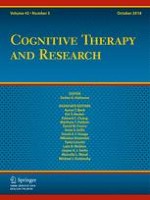23-04-2018 | Original Article
Development of the Interpretation Bias Index for PTSD
Gepubliceerd in: Cognitive Therapy and Research | Uitgave 5/2018
Log in om toegang te krijgenAbstract
Cognitive models of posttraumatic stress disorder (PTSD) implicate interpretation biases as a maintaining factor of symptoms. Existing measures index symptoms and negative beliefs in PTSD patients, but not threatening interpretation of socially-ambiguous information, which would further inform cognitive models of PTSD. Here we describe the development of a measure of interpretation bias specific to individuals with PTSD. Studies 1 and 2 utilized analog samples to identify the smallest set of items capable of differentiating PTSD-specific interpretation biases. Study 3 utilized a clinical sample to examine the factor structure of the 9-item Interpretation Bias Index for PTSD (IBIP). A bifactor model fit the IBIP best, comprising a general PTSD factor and two subfactors. The IBIP was most strongly related to PTSD symptoms and demonstrated sensitivity and specificity to detecting true PTSD cases. The IBIP has potential clinical utility for tracking interpretation bias in PTSD, or even screening for PTSD diagnoses.
